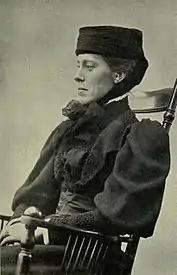Albert George Dew-Smith | |
|---|---|
| Born | Albert George Dew October 27, 1848 Salisbury, England |
| Died | March 17, 1903 (aged 54) Fulham, London |
| Nationality | British |
| Alma mater | Trinity College, Cambridge |
| Known for | electrical stimulation of muscles; photography; scientific equipment manufacture |
| Spouse | Alice Lloyd |
Albert George Dew-Smith (27 October 1848 – 17 March 1903)[1] was a British physiologist, lens maker, bibliophile, and amateur photographer. He co-founded the Cambridge Scientific Instrument Company, and conducted early research with physiologist Michael Foster.
Personal life and education
A. G. Dew-Smith was born in Salisbury, England to Charles Dew. He took the name Dew-Smith after inheriting substantial property in 1870.[lower-alpha 1] After being a pupil at Harrow School, he attended Trinity College, Cambridge, earning a B.A. (1873) and M.A. (1876) in Natural Sciences. He was an early student of Michael Foster, and conducted research on electrical stimulation of mollusc and frog hearts in the 1870s, making three working visits to the Naples Zoological Station. He enjoyed Italy and returned for visits later in his life.[1]: 53
In 1895 he married Alice Lloyd, a New Zealand-born author; they had no children.[3] They lived at Chesterton Hall on Chesterton Road, Cambridge. He died at Fulham, London, and is buried in Histon Road Cemetery, Cambridge.[1][4]
Career
A man of independent wealth, he financed the founding of The Journal of Physiology, of which Foster was the first editor. He was also a founding member of The Physiological Society.[5] By around 1876-78 Dew-Smith had left scientific research, although he maintained an interest in producing laboratory equipment as well as contact with scientists at Cambridge. He had his own workshop and ground high-quality microscope lenses.[1]: 53 Dew-Smith later launched the Cambridge Engraving Company, and in 1881 established the Cambridge Scientific Instrument Company with Horace Darwin.[6][7][8][9]
He became a noted photographer, particularly of portraits and scientific equipment. In 1884 he was elected a member of the Photographic Society of Great Britain and showed prints at the 1885 exhibition.[10] He was also a fellow and life member of the Cambridge Philosophical Society.[11]
He gave up every day involvement in commercial activities after his marriage. He continued with some photography and lithography for personal pleasure. This included facsimile productions of old books and manuscripts. Dew-Smith was a significant collector of art, literature and gems. His collecting had started when he inherited wealth in 1870. He owned many first editions and hand written manuscripts by authors such as William Blake, Lord Byron and Percy Bysshe Shelley.[1]: 59–68 He was a member of the Savile and Rabelais clubs in the 1880s and also the Society of Dilettanti in 1878.[1]: 54
References
- ↑ According to Walford's County Families, Dew assumed the name of Smith by royal license in 1870 under the will of the late William Smith, Esq., a banker of Salisbury.[2]
- 1 2 3 4 5 6 Viscomi, Joseph (2010). "Two Fake Blakes Revisited; One Dew-Smith Revealed". In Mulhallen, Karen (ed.). Blake in our Time: Essays in Honour of G.E. Bentley, Jr. University of Toronto Press. pp. 35–78. ISBN 9781442641518.
- ↑ Walford, Edward (1876). The County Families of the United Kingdom. London: Robert Hardwicke. p. 283.
- ↑ "A Database of Victorian Fiction". Retrieved 4 April 2018.
- ↑ "Dew, Albert George (DW868AG)". A Cambridge Alumni Database. University of Cambridge.
- ↑ O'Connor, W. J. (1988). Founders of British Physiology: A Biographical Dictionary, 1820-1885. Manchester University Press. pp. 182–. ISBN 978-0-7190-2537-2.
- ↑ Geison, Gerald L. (2015). Michael Foster and the Cambridge School of Physiology: The Scientific Enterprise in Late Victorian Society. Princeton University Press. pp. 182–. ISBN 978-1-4008-6911-4.
- ↑ Wall, Wilson John (2016). The Search for Human Chromosomes: A History of Discovery. Springer. pp. 28–. ISBN 978-3-319-26336-6.
- ↑ Foster, Michael (30 April 1903). "In Memoriam, A. G. Dew Smith". The Cambridge Review. 24: 261–262.
- ↑ Cattermole, M.J.G. (1987). "The Cambridge Scientific Instrument Company from 1881 to 1968". IEE Proceedings A. 134 (4): 351–358. doi:10.1049/ip-a-1.1987.0054.
- ↑ "Proceedings of Societies". The Photographic News. 11 January 1884. p. 30.
- ↑ The Cambridge University Calendar for the Year 1896–1897. Cambridge: Deighton Bell & Co. 1896. p. 991.
External links
- Portraits of Albert George Dew-Smith at the National Portrait Gallery, London
- "Archival material relating to Albert George Dew-Smith". UK National Archives.

.jpg.webp)
